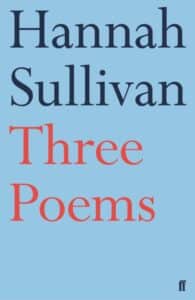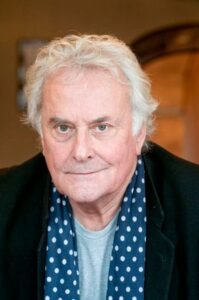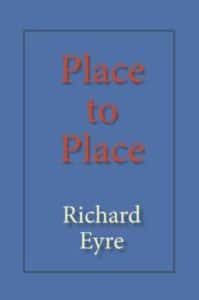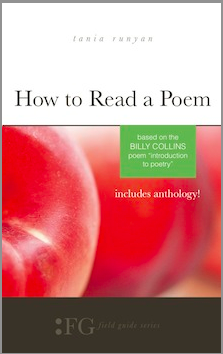
Hannah Sullivan and Richard Eyre turned to poetry to write autobiography
Poets have often used their own experiences for their poems. But I came across two collections from recent years that seemed to take experience a bit further and write autobiography in poetic form.
Hannah Sullivan studied classics at Cambridge and then attended Harvard, where she received a Ph.D. in English and American literature. She lived in New York City for a time, and then for three years was an assistant professor of English literature at Stanford University in California. She eventually returned to Britain and now is an associate professor at New College, Oxford.
Her experiences in New York and California left a powerful imprint, so much so that she published a poetry collection in 2018 that is an autobiographical memoir.

Hannah Sullivan
The collection’s title, Three Poems, defines the work’s structure. It’s not three long poems, but three sections composed of related (and often untitled but numbered) poems. The sense is that of a narrative; Sullivan is telling a story of her life and experiences. The first section is about New York, the second is about California, and the third is when she’s returned to England and focuses on the death of her father and the birth of her child.
Sullivan tells a story that is at once immediate and searingly raw. This isn’t a “tell-all” account, but it includes accounts of old lovers and relationships, especially in the first section. The California section becomes more of the story of life universal in California.
From Sullivan’s second poem:

Trader Joe’s, the Daily City multiplex,
Repetition’s sense of comedy
Unsheathed as architectural poverty:
Beige curves on Taco Bells,
And fog, the old dry ice machine.
Three sooty wraiths
Fade on a bridge like figures on a vase,
Faded already in an eighteenth-century house —
Stooped, waterthinned,
Chinoiserie
Some kid from Stanford GSB
Enters the 101 the wrong way round.
He kills two Puerto Rico passengers
And the taxi driver.
DUI. The Dean writes: ‘Our community
Can only get stronger
From this manifest tragedy.’
It is the third section, which interweaves of the death of her father and the birth of her child, that I found the most moving. She avoids sentimentality; at times the poem reads almost like a journalistic account. The interweaving of death and birth suggests both serve as mirrors of the same experience.
Three Poems won the T.S. Eliot Prize for Poetry in 2018. Sullivan used a similar structure for her 2023 collection, Was It for This, and continued the autobiographical theme.

Richard Eyre
Unless you’re British, you may not be familiar with the name Richard Eyre (born 1943). But you’ve likely seen the movies or the television series, or the plays and the operas he’s directed. Like Iris, the story of Iris Murdoch starring Dame Judi Dench; Atonement, with Keira Knightley and James McAvoy; and The Dresser with Anthony Hopkins and Ian McKellen, among many, many others. He’s been nominated for (and won or been involved in) countless Oscars, Tony Awards, BAFTA awards, Laurence Olivier Awards, and Golden Globes. From 1987 to 1999, he was the director of London’s National Theatre. He was appointed a Commander of the Order of the British Empire (OBE) in 1992 and knighted in 1997. The man has been a one-person cultural machine.
And, in 2018, he wrote a poetry collection, almost by accident. “I hadn’t planned this,” he writes. “I wrote a poem about my father and the rest followed.” “The rest,” as he calls Place to Place: Poems, was his autobiography.
He starts with places, like Dorset, where he grew up. He explains how he came to be interested in theater and film. He has poems about sets, location, rehearsals, editing, opening night, and end of the show. And places he’s worked on productions, such as Saigon, Edinburgh, Budapest, and Manchester.
Eyre also considers nature, calling it “an experiment in seeing” and the seasons serving as a life’s signposts.
Box in Winter

It costs the blades of grasses.
Blesses the anemone pearls,
Graces the rosehip gemstones.
Leaves have lost their loyalty
Blown away, dropped out;
Earth their refuge, draws in its breath
And the seeds beneath await their call.
Something is in the air, invisible,
An almost breeze: almost motionless.
The orchestra of branches is poised,
Waiting for spring’s downbeat.
Appropriately, I found Place to Place in the bookshop of the National Theatre on London’s South Bank, where Eyre worked for more than a decade. I knew his name because he was the executive producer for the movie Atonement, based on the novel by Ian McEwan, one of the most haunting movies I’ve ever seen.
If you enjoy autobiography as poetry, or vice versa, Sullivan’s Three Poems and Eyre’s Place to Place are excellent examples to read and study. Sullivan’s meshing of death and birth is almost astonishing, while Eyre’s poems described a life lived well and a life worked well.
Related:
A Review of Hannah Sullivan’s Was It for This at the Poetry Foundation
Photo by jimmy brown, Creative Commons, via Flickr. Post by Glynn Young.
How to Read a Poem uses images like the mouse, the hive, the switch (from the Billy Collins poem)—to guide readers into new ways of understanding poems. Anthology included.
“I require all our incoming poetry students—in the MFA I direct—to buy and read this book.”
—Jeanetta Calhoun Mish
- “Your Accent! You Can’t Be from New Orleans!” - October 9, 2025
- Poets and Poems: Donna Vorreyer and “Unrivered” - October 7, 2025
- Poet Sidney Lanier and the Lost Cause - October 2, 2025

Leave a Reply